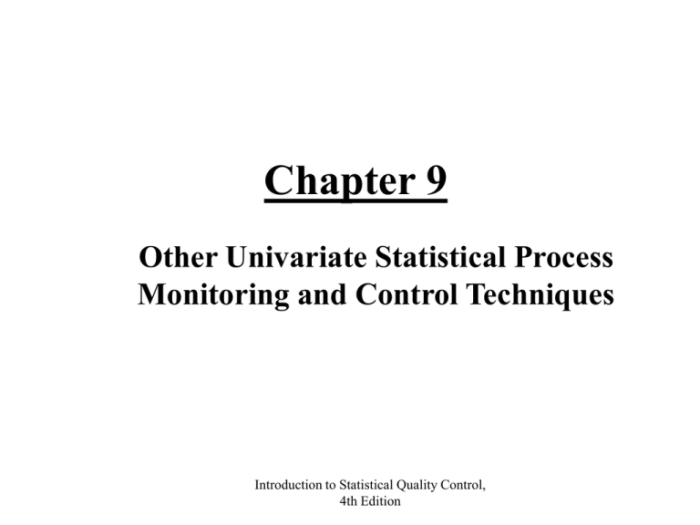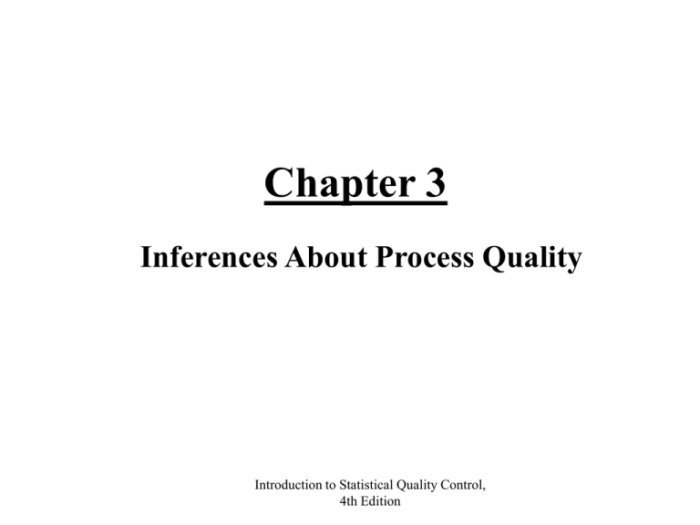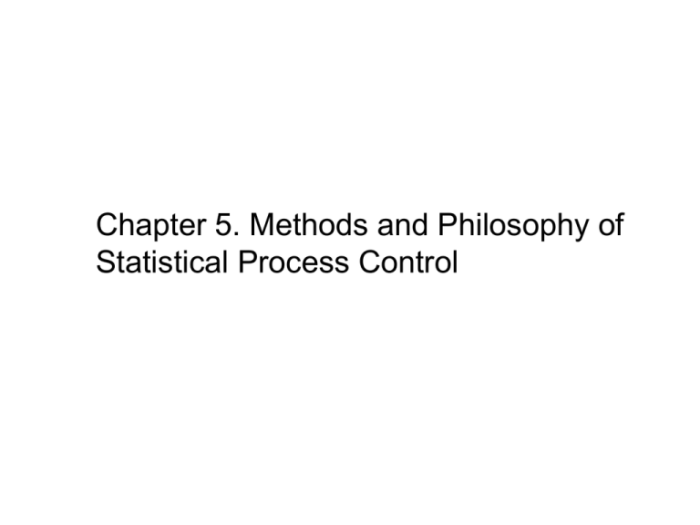Introduction to statistical quality control 8th edition – Embark on a transformative journey with the 8th edition of “Introduction to Statistical Quality Control,” a seminal work that unveils the fundamental principles and cutting-edge applications of statistical quality control (SQC). Delve into the historical evolution, objectives, and benefits of SQC, gaining invaluable insights into its role in shaping modern quality management practices.
This comprehensive guide provides an in-depth exploration of Statistical Process Control (SPC), acceptance sampling, Design of Experiments (DOE), reliability engineering, and quality management systems. Through real-world case studies, you’ll witness the transformative power of SQC in enhancing quality and efficiency across diverse industries.
1. Introduction to Statistical Quality Control
Statistical quality control (SQC) is a powerful set of techniques used to ensure the quality of products and services. It involves the application of statistical methods to monitor, analyze, and improve processes.
SQC has a rich history, dating back to the early 20th century. Pioneers like Walter Shewhart and W. Edwards Deming developed fundamental concepts and tools that are still widely used today.
The key objectives of SQC include:
- Reducing variation and improving consistency
- Identifying and eliminating defects
- Optimizing processes for efficiency and effectiveness
By implementing SQC, organizations can reap numerous benefits, such as:
- Improved customer satisfaction
- Reduced costs
- Enhanced productivity
- Increased profitability
2. Statistical Process Control (SPC)
SPC is a fundamental component of SQC that focuses on monitoring and controlling processes to ensure they operate within acceptable limits.
SPC involves the use of control charts, which are graphical tools that display data over time. Control charts help identify patterns and trends that may indicate process shifts or other problems.
Different types of control charts are used depending on the type of data being monitored. Some common control charts include:
- X-bar and R charts (for variables data)
- p-chart (for attribute data)
- c-chart (for counts of defects)
Process capability analysis is another important aspect of SPC. It involves assessing the ability of a process to meet customer requirements and identifying opportunities for improvement.
3. Acceptance Sampling: Introduction To Statistical Quality Control 8th Edition

Acceptance sampling is a statistical method used to decide whether to accept or reject a lot of products based on a sample.
There are different types of acceptance sampling plans, each with its own advantages and disadvantages. Some common plans include:
- Single sampling plan
- Double sampling plan
- Multiple sampling plan
The operating characteristic (OC) curve is a graphical tool used to evaluate the performance of an acceptance sampling plan. The OC curve shows the probability of accepting a lot as a function of the true quality level of the lot.
4. Design of Experiments (DOE)

DOE is a statistical method used to investigate the relationship between input variables and output responses.
DOE involves designing experiments in a systematic way to ensure that the results are valid and reliable.
There are different types of experimental designs, each with its own strengths and weaknesses. Some common experimental designs include:
- Factorial design
- Response surface design
- Taguchi design
Data analysis and interpretation are important aspects of DOE. Statistical methods are used to analyze the data and identify significant factors that affect the output responses.
5. Reliability Engineering

Reliability engineering is a branch of engineering that deals with the reliability of products and systems.
Reliability is defined as the probability that a product or system will perform its intended function for a specified period of time under specified conditions.
There are different types of reliability models, each with its own assumptions and applications. Some common reliability models include:
- Exponential distribution
- Weibull distribution
- Lognormal distribution
Reliability testing and data analysis are important aspects of reliability engineering. Statistical methods are used to analyze the data and estimate the reliability of products and systems.
6. Quality Management Systems

Quality management systems (QMS) are frameworks that help organizations manage and improve the quality of their products and services.
There are different types of QMS standards, each with its own requirements. Some common QMS standards include:
- ISO 9001
- AS9100
- IATF 16949
Implementing a QMS can provide numerous benefits to organizations, such as:
- Improved customer satisfaction
- Reduced costs
- Enhanced productivity
- Increased profitability
FAQ Resource
What is the primary focus of the 8th edition of “Introduction to Statistical Quality Control”?
The 8th edition provides a comprehensive overview of the fundamental principles and applications of statistical quality control (SQC), emphasizing its role in modern quality management practices.
How does the book explore the different aspects of SQC?
The book covers a wide range of topics, including Statistical Process Control (SPC), acceptance sampling, Design of Experiments (DOE), reliability engineering, and quality management systems.
What is the significance of real-world case studies in the book?
The case studies demonstrate the practical applications of SQC and showcase its transformative impact on quality and efficiency in various industries.